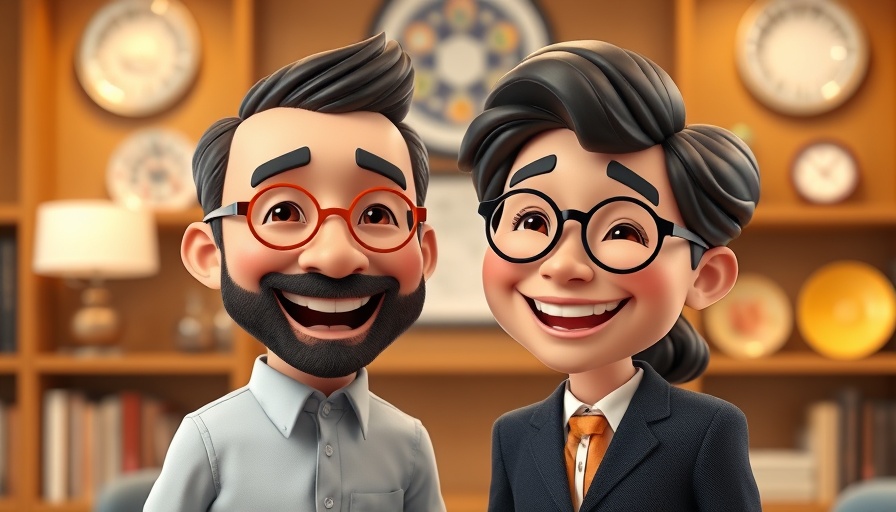
AI Art Meets Politics: A New Frontier
In an intriguing blend of technology and politics, Prime Minister Narendra Modi recently engaged with the viral AI art trend inspired by Studio Ghibli, the beloved Japanese animation studio known for its enchanting storytelling and artistry. The Indian government showcased a series of AI-generated images that reimagined significant events from Modi's leadership in the iconic whimsical style synonymous with films like "Spirited Away" and "My Neighbor Totoro." This phenomenon, which highlights the union of artificial intelligence and creative expression, invites viewers to consider the role of technology in shaping public perceptions of political figures.
Why Ghibli-Style Modi is Turning Heads
The government took to social media platform X to unveil a collection of colorful portraits depicting Modi in various roles—a leader engaging with global statesmen, donning military attire, and even in moments of lightheartedness. This initiative resonates with the public, capturing both significant milestones and personal moments in a fantastical light.
The AI-created art features Modi next to global leaders such as former U.S. President Donald Trump, showing the importance of diplomacy during his administration. Other images capture the Prime Minister’s active participation in significant cultural and national events, reflecting an effort to humanize a figure often seen through a political lens. For instance, one image depicts Modi beside the national flag, evoking collective pride and patriotism.
Exploring the Intersection of AI and Art
This trend is not just about showcasing Modi; it's indicative of a broader cultural movement where AI tools democratize creativity. Shashi Tharoor, a prominent Congress leader, also joined the Ghibli trend on social media, expressing surprise at the enthusiasm around his own images remixed into the artistic style. “Didn’t even know what Ghibli was till now,” Tharoor commented, showcasing a personal engagement with the trend that mirrors a larger societal embrace of AI innovations.
The Studio Ghibli-style artwork exemplifies how technology like AI can bridge the gap between public figures and their audience, presenting them in a new, relatable manner. It invites discussion about the implications of AI art: is it simply digital fun, or does it have deeper meanings regarding identity representation in politics?
The Digital Age of Representation
This trend occurs at a critical time when social media shapes narratives and public images vote for the leaders. By embracing the Ghibli style, Modi’s portrayal shifts perceptions and invites public discourse about his administration's contributions, thereby altering the narrative among the populace.
Notably, the impact of such artistic representations in modern politics cannot be overlooked. The Ghibli-inspired portraits serve to soften often serious political discussions by adding a whimsical flair that evokes nostalgia and warmth, which could resonate well with younger audiences who are increasingly seeking genuine connections with their leaders.
Trends in AI Art Within the Political Sphere
The popularity of this Ghibli challenge raises questions about how AI art intersects with political messaging. As more public figures engage with this trend, the question remains: Could we see a rise in AI imagery being used strategically for political campaigning? As technology continues to advance, it may reshape the landscape of political imagery and representation.
In a world where AI-generated art becomes more accessible, the potential for innovation in political discourse is boundless. Ethical implications aside, the Ghibli trend could pave the way for more emotionally resonant portrayals of public figures, blending artistry and governance in ways we have yet to fully explore.
Concluding Thoughts
The captivating mix of PM Modi and AI-generated Studio Ghibli art reflects broader trends in how technology influences politics and public perception. By embracing AI art, leaders may forge deeper connections with their constituents, reimagining their narratives in an attractive form. As technology continues to evolve, it's essential for the public to engage critically with these representations and understand their implications on political culture.
If you're fascinated by the intersection of technology and creativity, it's time to explore other ways AI is transforming our understanding of art and representation in politics. Engaging with these trends not only supports innovation but also fosters discussions about our leaders and their portrayal in the digital realm.
 Add Row
Add Row  Add
Add 




 Add Row
Add Row  Add
Add 

Write A Comment